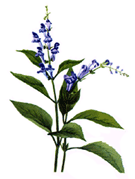
Skullcap
Introduction
This fact sheet provides basic information about Skullcap. Scullcap ( S. lateriflora ), a member of the mint family, is native to the United States where it grows in moist woods. Although it is widely distributed throughout large regions of North America, there are related species found as far away as China. There are over 300 species of Scutellaria worldwide. Common scullcap ( Scutellaria lateriflora ) is the best known of these species.Scullcap appears to have been introduced into traditional American medicine toward the end of the 1700s, when it was called mad-dog skullcap because of its use as a treatment for rabies. It was later used as a tonic, particularly in proprietary remedies for "female weakness." The plant was reputed to be an herbal tranquilizer, particularly in combination with valerian, but has fallen into disuse.
Scullcap has traditionally been used to treat nervousness, irritability, and neuralgia, as well as for its sedative properties.
Common Names
Scullcap, Blue Skullcap, Helmetflower, Hoodwort, Mad-Dog Weed, Virginian SkullcapLatin Names
Scutellaria laterifloraWhat It Is Used For
- Scullcap traditionally has been used as a sedative for nervousness and anxiety, although there is little to no data to support any of these uses.
How It Is Used
Limit doses of American skullcap to no more than the package recommendation. Typical doses (see individual product information):- Dried herb: 1 to 2 grams 3 times/day.
- Tea: 240 mL 3 times/day (Pour 250 mL of boiling water over 5 to 10 mL of the dried herb and steep for 10 to 15 minutes).
- Tincture: 2 to 4 mL 3 times/day.
What the Science Says
- The FDA presently designates scullcap as a herb of undefined safety.
Side Effects and Cautions
- None well documented. However, because American skullcap may promote sleepiness, it may intensify the effects of drugs that also cause drowsiness. The effects of the drug may be exaggerated, resulting in sedation or mental impairment.
Sources
- Drugs.Com Web site. Accessed on February 7, 2009.
- From Wikipedia, the free encyclopedia. Accessed on February 7, 2009.






